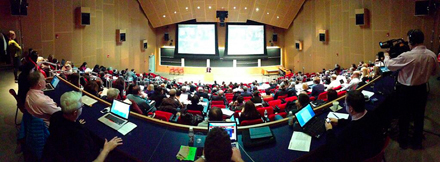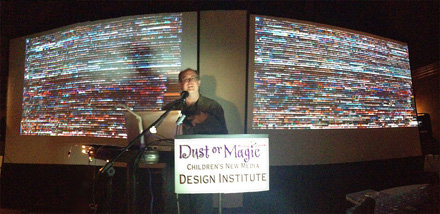Tuesday, November 11th, 2014
Where do you go to stay smart in the kids interactive industry? What conferences keep you on top of your craft, while also helping you grow your network? What events are vital to attend to learn the latest trends? There are so many conferences these days which ones are right for you? Look no further, here’s a compiled conference list to get you started! It covers areas of the children’s interactive media business like toys, eBooks, video games, children’s television, apps, play, research, consumer products, and more. The list below covers most of the big US and international shows in 2015, and just a few important smaller events.
You can download a PDF copy of this list here. Let us know what you think. Which events do you attend? What speakers draw you to an event? If there’s an event that’s not on this list, and you think it’s important, please let us know in the comments below.
| # | Conference w link | Location | Date(s) | Focus |
|---|---|---|---|---|
| 1 | Consumer Electronics Show (CES) | Las Vegas, NV | 1/6-9/15 | Hardware, tech |
| 2 | Kids@Play | Las Vegas, NV | 1/7/15 | KidTech |
| 3 | Hong Kong Toys & Games Fair | Hong Kong | 1/12-15/15 | Toys |
| 4 | Digital Book World | New York, NY | 1/13-15/15 | eBooks |
| 5 | FETC | Orlando, FL | 1/20-23/15 | Ed tech |
| 6 | PAXsouth | San Antonio, TX | 1/23-25/15 | Gaming |
| 7 | Nuremburg Toy Fair | Nuremburg | 1/28-2/2/15 | Toys |
| 8 | NY Toy Fair | New York, NY | 2/14-17/15 | Toys |
| 9 | Digital Kids Conference | New York, NY | 2/15-17/15 | KidTech |
| 10 | Kidscreen Summit | Miami, FL | 2/23-26/15 | Broadcast, Children’s TV |
| 11 | iKids | Miami, FL | 2/26/15 | KidTech |
| 12 | Game Developers Conference (GDC) | San Fran, CA | 3/2-6/15 | Gaming |
| 13 | PAXeast | Boston, MA | 3/6-8/15 | Gaming |
| 14 | SXSWedu | Austin, TX | 3/9-12 2015 | Education |
| 15 | SXSW Gaming Expo | Austin, TX | 3/13-16/15 | Gaming |
| 16 | SXSW Interactive | Austin, TX | 3/13-17/15 | Interactive |
| 17 | SXSW Music | Austin, TX | 3/17-22/15 | Music |
| 18 | Society for Research in Child Development (SRCD) | Philadelphia, PA | 3/19-21/15 | Research |
| 19 | Sandbox Summit | Cambridge, MA | 3/22-24/15 | Play |
| 20 | Dust or Magic Masterclass | Bologna | 3/25/15 | eBooks |
| 21 | Bologna Children’s Book Faire | Bologna | 3/30-4/2/15 | Books |
| 22 | Early Education & Technology for Children (EETC) | Salt Lake City, UT | 3/15 | Early ed, edtech |
| 23 | London Book Fair | London, UK | 4/14-16/15 | Books |
| 24 | Games for Change | New York, NY | 4/21-23/15 | Serious games |
| 25 | Dust or Magic eBook Retreat | Honesdale, PA | 4/15 | eBooks |
| 26 | PlayCon | Scottsdale, AZ | 4/29-5/1/15 | Toys |
| 27 | Software & Information Industry Association (SIIA) | San Fran, CA | 5/3-5/15 | Ed tech |
| 28 | Maker Faire Bay Area | San Mateo, CA | 5/16-17/15 | Maker |
| 29 | Book Expo America (BEA) | New York, NY | 5/27-29/15 | eBooks |
| 30 | AppCamp | Pacific Grove, CA | 5/30-6/2/15 | Children’s Apps |
| 31 | “Content in Context (CIC, AAP) | Wash DC | 6/1-3/15 | Ed publishing |
| 32 | NAEYC Professional Development conference | New Orleans, LA | 6/7-10/15 | Early ed |
| 33 | Licensing Expo | Las Vegas, NV | 6/9-11/15 | Licensing |
| 34 | Digital Media & Learning (DML) | LA, CA | 6/11-13/15 | Ed tech |
| 35 | E3 | LA, CA | 6/16-18/15 | Gaming |
| 36 | Interaction Design & Children (IDC) | Medford, MA | 6/21-24/15 | Research |
| 37 | International Society for Technology in Education (ISTE) | Philadelphia, PA | 6/28-7/1/15 | Ed tech |
| 38 | Children’s Media Conference (Professional) | Sheffield, UK | 7/1-3/15 | Broadcast |
| 39 | Playful Learning Summit | Maddison, WI | 7/7/15 | Serious games |
| 40 | Games, Learning & Society (GLS) | Maddison, WI | 7/8-10/15 | Serious games |
| 41 | ComicCom | San Diego, CA | 7/9-12/15 | Entertainment |
| 42 | International Reading Association (IRA) | St. Louis, MO | 7/17-20/15 | Education, reading |
| 43 | Serious Play | LA, CA | 7/15 | Serious games |
| 44 | Casual Connect | San Fran, CA | 8/11-13/15 | Gaming |
| 45 | Burning Man | Black Rock Desert, NV | 8/29-9/5/15 | Art, mind |
| 46 | Digital Kids Summit | San Fran, CA | 9/15 | KidTech |
| 47 | World Congress of Play | San Fran, CA | 9/15 | Toys |
| 48 | Maker Faire New York | New York, NY | 9/26-27/15 | Maker |
| 49 | MIP Jr. | Cannes, France | 10/2-4/15 | Children’s television |
| 50 | MDR EdNet | Atlanta, GA | 10/4-6/15 | Ed tech |
| 51 | MIPcom | Cannes, France | 10/5-8/15 | Television |
| 52 | Fall Toy Preview | Dallas, TX | 10/6-8/15 | Toys |
| 53 | Meaningful Play | East Lansing, MI | 10/15 | Serious games |
| 54 | CineKid | Amsterdam | ~10/18-22/15 | Interactive |
| 55 | Dust or Magic | Lambertville, NJ | 11/1-3/15 | Kidtech, children’s apps |
| 56 | NAEYC Annual Conference | TBA | 11/15 | Early ed |
| 57 | ChiTAG | Chicago, IL | 11/20-23/15 | Toys |
| 58 | SIIA Education Business Forum | New York, NY | 12/15 | Ed tech |
| 59 | Star Wars Episode VII release | US | 12/18/15 | Entertainment |
NOTE: Items highlighted in red indicate specifics about an event that have yet to be announced as of 11/10/2014.





